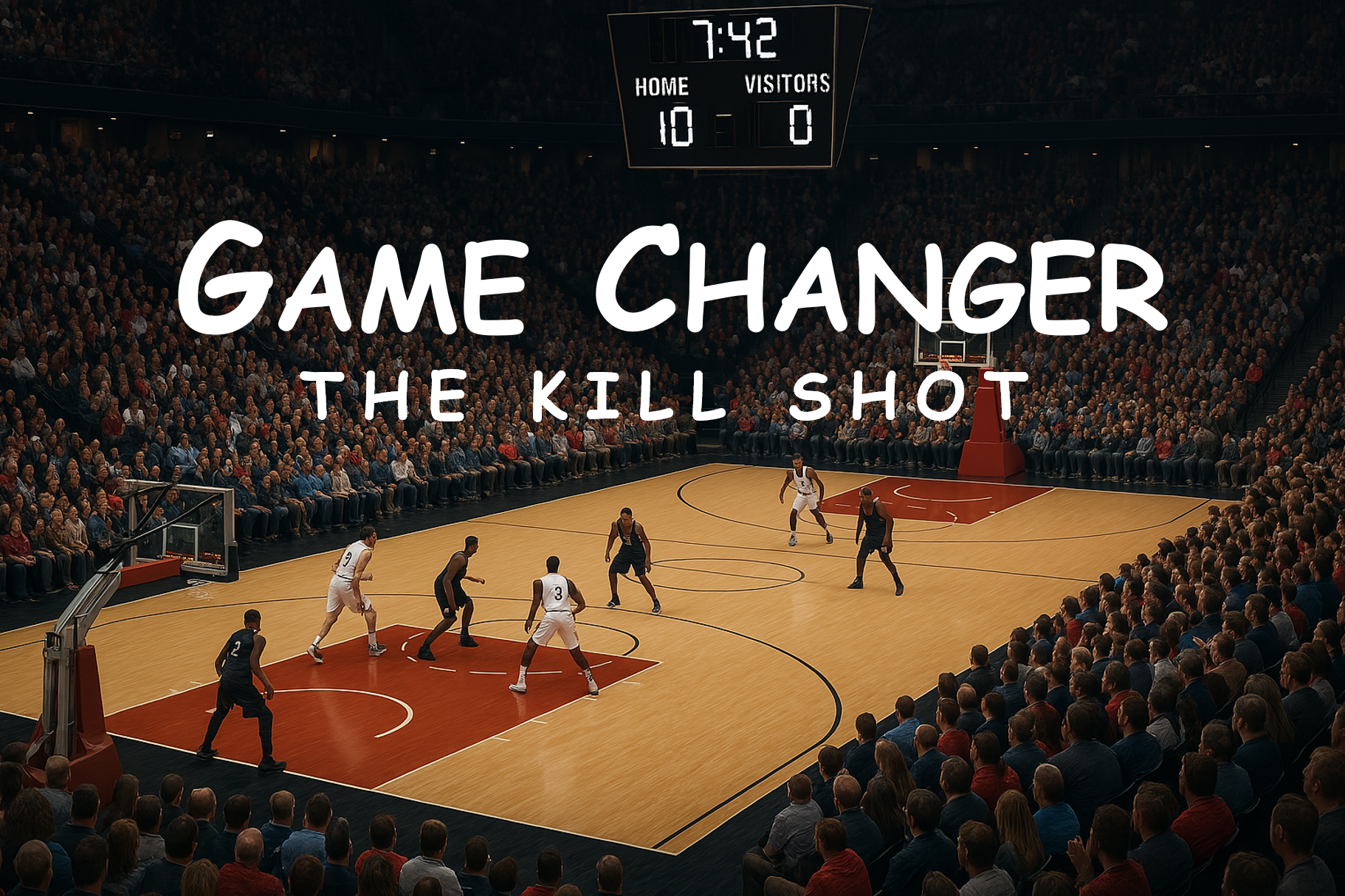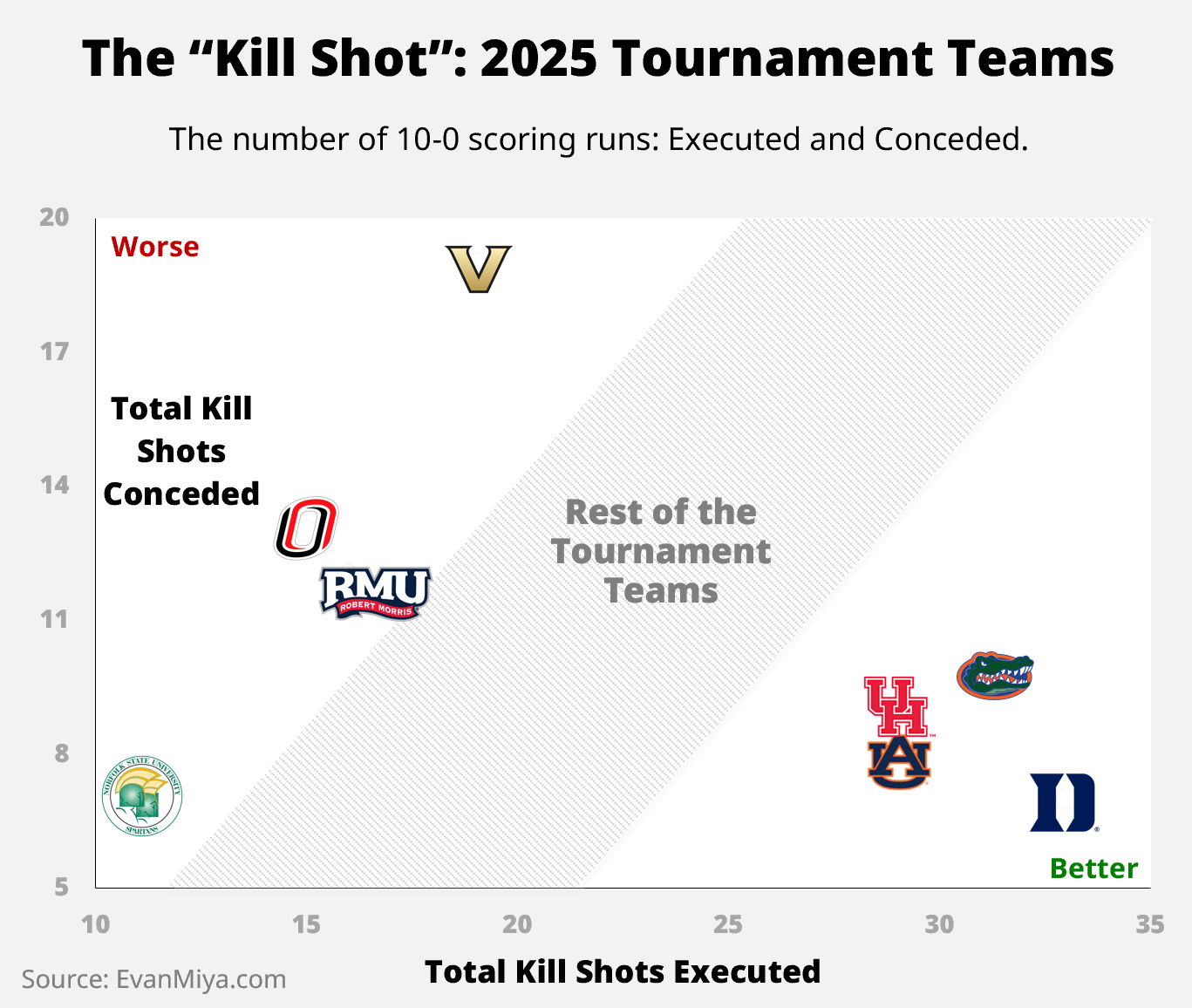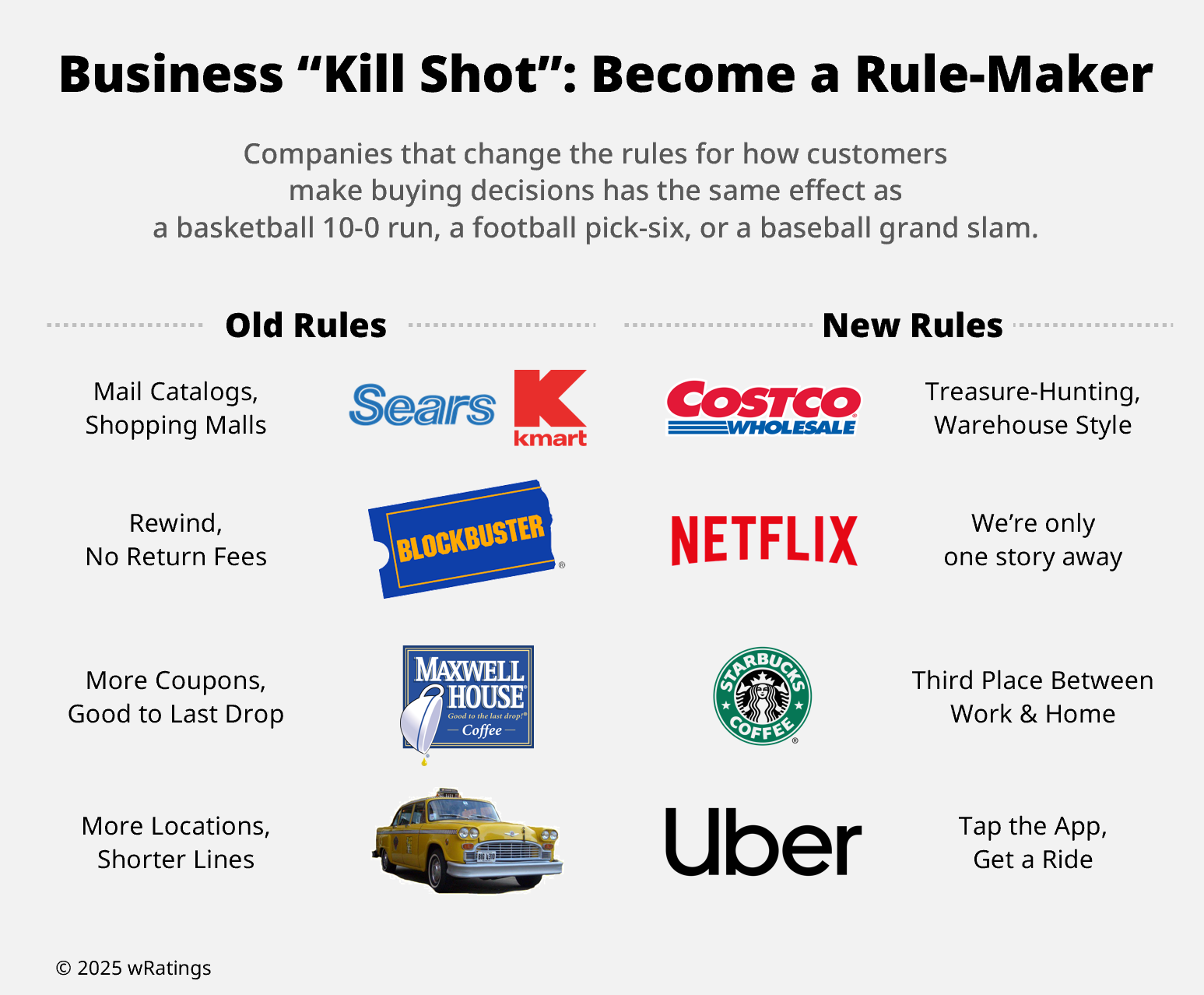March Madness: Kill Shots by the Gators, Houston, Netflix, and Uber
Jon Moritz
April 8, 2025
March Madness: Kill Shots by the Gators, Houston, Netflix, and Uber
Gary A. Williams
wRatings Founder & CEO

All trademarks are properties of their respective owners.
First off, congratulations to Florida for winning the national championship, and to Houston for giving all they got to almost win their first championship. No “Kill Shots” were executed, but I’m sure Houston felt like they conceded one as they gave up a 12-point lead. To see the power of a Kill Shot in action, we need to go back to how each team got to the final game.
In last week’s blog, we detailed out how dominant the 2025 Duke Basketball team was not only against this year’s competition, but against all teams going back to when the KenPom.com (Moneyball) statistics were unveiled. But as the Kentucky basketball coach Adolph Rupp famously said back in 1965, “That’s why we play the game to see who’ll win.”
Let’s dig into a relatively new, but powerful basketball analytic created by Evan Miyakawa in 2022: The Kill Shot. It has a straight-forward definition: A team’s ability to go on a scoring run of 10-0. Charles Barkley refers to this concept as “spurtability” – which I believe should be a word but likely isn’t.
Similarly, some companies also have that spurtability – that Kill Shot – where they change the way business gets done in what feels like an instant to their competitors.
Here’s the story behind The Kill Shot in basketball and business.

Back Breaking Moments
Kill Shots are one of the most reliable ways to predict the outcome of a single game. Miyakawa’s data shows a team with at least one 10-0 run wins 71% of the time. A 15-0 run leads to a win 86% of the time, and a 20-0 run leads to a win 91% of the time. In other words, Kill Shot data works tremendously well for a single game outcome.
Down 49-40 on Saturday night, Florida went on an 11-0 run starting with 18:24 left in the second half. Nearly three minutes later (15:30 mark), Walter Clayton Jr. made a jump shot to put Florida up 51-49. The game was far from over, but the Kill Shot created enough momentum that Florida eventually won by six points.
Prior to the tournament, Duke was the #1 team ranked in Adjusted Kill Shots Margin at 0.60 with 33 total Kill Shots executed and only 7 conceded. That was a full 0.12 better than Houston, who had 29 Kill Shots with only 9 conceded this season, which gave them a #7 ranking [Florida was #8 at0.47 and Auburn #10 at 0.45].
The Duke-Houston game turned on a dime, well maybe two dimes. With 8:17 to play in the game, Duke was up by a comfortable 14 points, 59-45. Then Houston went on 10-0 scoring run over the next 3 minutes and 14 seconds to close within 4 points. Kill Shot executed, and Houston’s chance of winning goes up to 71% according to EvanMiya.com.
Then, while technically not a Kill Shot, Houston went on an 9-0 run in the final 1:14 to beat Duke by three points. A stunning collapse by the top rated KenPom team.
Let’s face it. Kill Shots are enormously difficult to pull off. A team must be exceedingly strong at both ends of the court, play a smothering defense while grabbing rebounds and take/make smart shots. Kill Shots are the equivalent of the grand slam in baseball, or pick-six or kickoff return in football. The momentum shifts in that team’s favor.
Rule-Making Moments
Similar to any single business analytic, the Kill Shot should not be used in a vacuum. But it’s a helpful tool to gauge momentum and launch a team to victory. And in business, momentum can be huge to launch a company’s sales growth.
While most companies wait to introduce a product with new features, numerous other ways exist to generate momentum and change the trajectory of a company’s sales growth. Just like a Kill Shot, the concept is straight-forward but the execution takes both skill and courage.
A business “Kill Shot” happens when a company changes the rules for how customers make buying decisions. Most companies are rule-takers, not rule-makers, and this holds them back from accelerating their growth. Rule-takers play the game of business safely and don’t bother to challenge the status quo.
Rule-Makers take control of the market. They reset customer expectations in their direction so they can outperform rivals and jump start their sales growth. They create new rules that force competitors to follow them. This shifts new customers into their ecosystem while increasing wallet share from current ones.
Here are a few examples of how Rule-Makers took control of their market:
● Costco vs. Sears/K-Mart. Rather than K-Mart’s blue light specials, Costco transformed the shopping experience from malls and catalogs to warehouses and treasure hunting. Ironically, Costco was formed in the 1970s when Sears was at its peak.
● Netflix vs. Blockbuster. Netflix introduced original content that could be binge watched via streaming, vastly outsmarting the ‘unwilling to change’ Blockbuster store approach.
● Starbucks vs. Maxwell House. While Maxwell House had the perfect name to create a third place between work and home, Starbucks created a whole new category of premium coffee that didn’t require grocery aisles and discount coupons.
● Uber vs. Yellow Cab. When Apple introduced their smartphone, Yellow Cab could have easily created an app that would summon a ride to anyone’s location. Instead, Uber created a new rule for how transportation gets done.
In retrospect, these all seem obvious.. At the time though, the new rule was deemed risky because customers were asked to create a new habit. Yet, new habits are formed all the time. The key is to offer customers a compelling set of value that improves their lives. The true risk is to continue to be a rule-taker, where a competitor could grab more market share or worse: Put you out of business.

Be a Rule-Maker, not a Rule-Taker
Don’t ever concede the equivalent of a Kill Shot in your industry. Make sure you are the one creating the new rules.
Let the wRatings platform show you the customer analytics where new rules are needed today, and that will drive your sales growth.
If you’d like access to our Moneyball analytics and our benchmarking database, apply to become a wRatings Insider.
© 1999-2025 wRatings. All rights reserved / Privacy Policy


